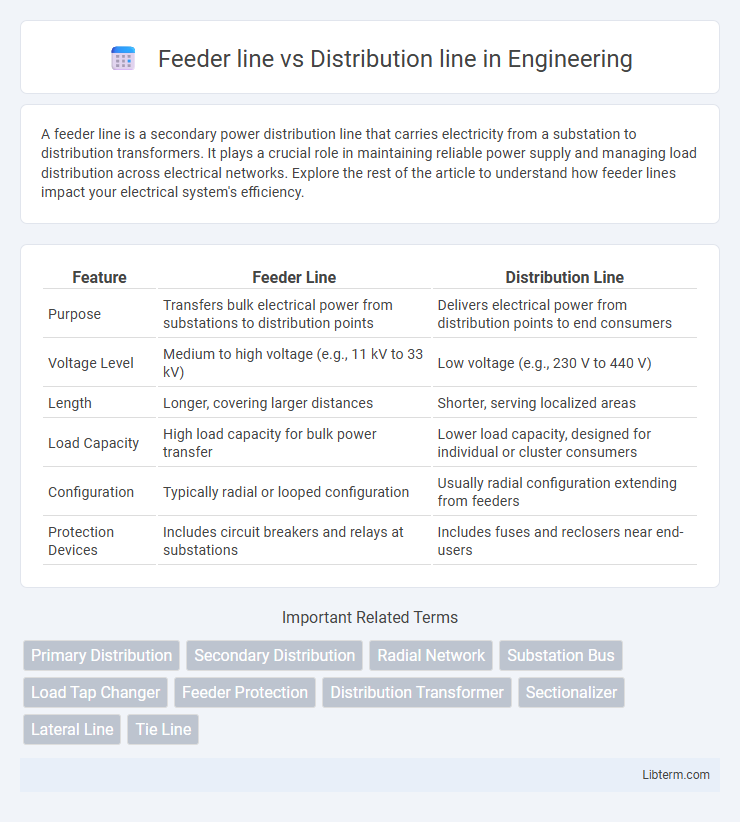A feeder line is a secondary power distribution line that carries electricity from a substation to distribution transformers. It plays a crucial role in maintaining reliable power supply and managing load distribution across electrical networks. Explore the rest of the article to understand how feeder lines impact your electrical system's efficiency.
Table of Comparison
| Feature | Feeder Line | Distribution Line |
|---|---|---|
| Purpose | Transfers bulk electrical power from substations to distribution points | Delivers electrical power from distribution points to end consumers |
| Voltage Level | Medium to high voltage (e.g., 11 kV to 33 kV) | Low voltage (e.g., 230 V to 440 V) |
| Length | Longer, covering larger distances | Shorter, serving localized areas |
| Load Capacity | High load capacity for bulk power transfer | Lower load capacity, designed for individual or cluster consumers |
| Configuration | Typically radial or looped configuration | Usually radial configuration extending from feeders |
| Protection Devices | Includes circuit breakers and relays at substations | Includes fuses and reclosers near end-users |
Introduction to Power Distribution Networks
Feeder lines are medium-voltage power cables that transport electricity from substations to distribution transformers, serving as the primary arteries of power distribution networks. Distribution lines operate at lower voltages, delivering electric power from transformers directly to end consumers in residential, commercial, and industrial areas. This hierarchical structure ensures efficient voltage regulation and reliable delivery within power distribution networks.
Understanding Feeder Lines
Feeder lines are high-capacity electrical conductors that transport power from substations to distribution lines, serving as critical arteries in the power distribution network. They typically operate at higher voltage levels and handle larger currents compared to distribution lines, enabling efficient bulk transmission of electricity over longer distances. Understanding feeder lines involves recognizing their role in maintaining system reliability, minimizing losses, and ensuring stable voltage before electricity reaches lower-voltage distribution lines that deliver power to end-users.
What Are Distribution Lines?
Distribution lines are power lines that deliver electricity from substations to individual consumers, operating at lower voltages than feeder lines. They typically carry voltages ranging from 4 kV to 33 kV, ensuring safe and reliable power supply to residential, commercial, and industrial users. Distribution lines often include transformers that step down voltage to usable levels for end-users, facilitating efficient electricity distribution within a localized area.
Key Differences Between Feeder and Distribution Lines
Feeder lines deliver high-voltage power from substations to distribution transformers, serving as the main arteries in the power distribution network with typical voltages ranging from 4kV to 34.5kV. Distribution lines carry lower voltage electricity from transformers to end consumers, usually operating between 120V and 480V for residential and commercial use. The primary difference lies in their voltage levels and function: feeder lines transport bulk power over long distances, while distribution lines provide localized, lower voltage supply directly to customers.
Roles and Functions in Electrical Grids
Feeder lines in electrical grids are responsible for transmitting bulk electrical power from substations to distribution lines, operating at medium to high voltage levels to ensure efficient long-distance delivery. Distribution lines then reduce the voltage and deliver electricity directly to end-users such as homes, businesses, and industries, providing the final stage of power delivery. The distinct roles emphasize feeder lines as primary power carriers and distribution lines as the critical interface for consumer access and voltage regulation in the grid.
Voltage Levels: Feeder Line vs Distribution Line
Feeder lines typically operate at medium voltage levels ranging from 4 kV to 35 kV, serving as the main conductors that channel power from substations to distribution transformers. Distribution lines function at lower voltage levels, commonly between 120 V and 600 V, delivering electricity directly to residential, commercial, and industrial consumers. The step-down transformation from feeder to distribution voltage ensures safe and reliable power supply suited to end-user requirements.
Infrastructure Design and Layout
Feeder lines serve as primary conduits in power distribution systems, typically carrying high voltage electricity from substations to distribution transformers with minimal branching, ensuring efficient bulk power transfer. Distribution lines extend from these transformers, stepping down voltage and branching extensively to deliver electricity directly to end-users, requiring intricate layout design to accommodate varied load densities and urban or rural landscapes. Infrastructure design prioritizes the durability and voltage levels of feeder lines, with robust poles and conductors, while distribution lines focus on flexibility and accessibility to support residential and commercial connections.
Reliability and Maintenance Considerations
Feeder lines are designed to carry larger currents over longer distances and connect primary substations to distribution transformers, making their reliability crucial for minimizing widespread outages. Distribution lines, serving as the final step in delivering electricity to consumers, require frequent maintenance to address frequent exposure to environmental factors and localized faults. Effective maintenance strategies for feeder lines focus on preventing major disruptions, while distribution line upkeep prioritizes quick fault detection and restoration to enhance overall system reliability.
Applications in Urban and Rural Areas
Feeder lines serve as primary power carriers from substations to distribution transformers, crucial in both urban and rural electricity supply systems. In urban areas, feeder lines handle high load densities with complex branching to ensure reliable power delivery to commercial and residential zones, while in rural regions, they often span longer distances with simpler configurations to cover dispersed settlements. Distribution lines, emanating from feeder lines, provide the final voltage step-down and direct connections to consumers, adapting to the specific demands of urban street grids or rural agricultural and household needs.
Choosing the Right Line for Your Power Needs
Feeder lines carry high voltage electricity from substations to distribution points, making them essential for efficient transmission over long distances with minimal loss. Distribution lines then step down voltage and deliver power directly to homes and businesses, optimizing safety and accessibility for end-users. Selecting the right line depends on your power demand, distance from substations, and voltage requirements to ensure reliable and cost-effective energy delivery.
Feeder line Infographic

 libterm.com
libterm.com